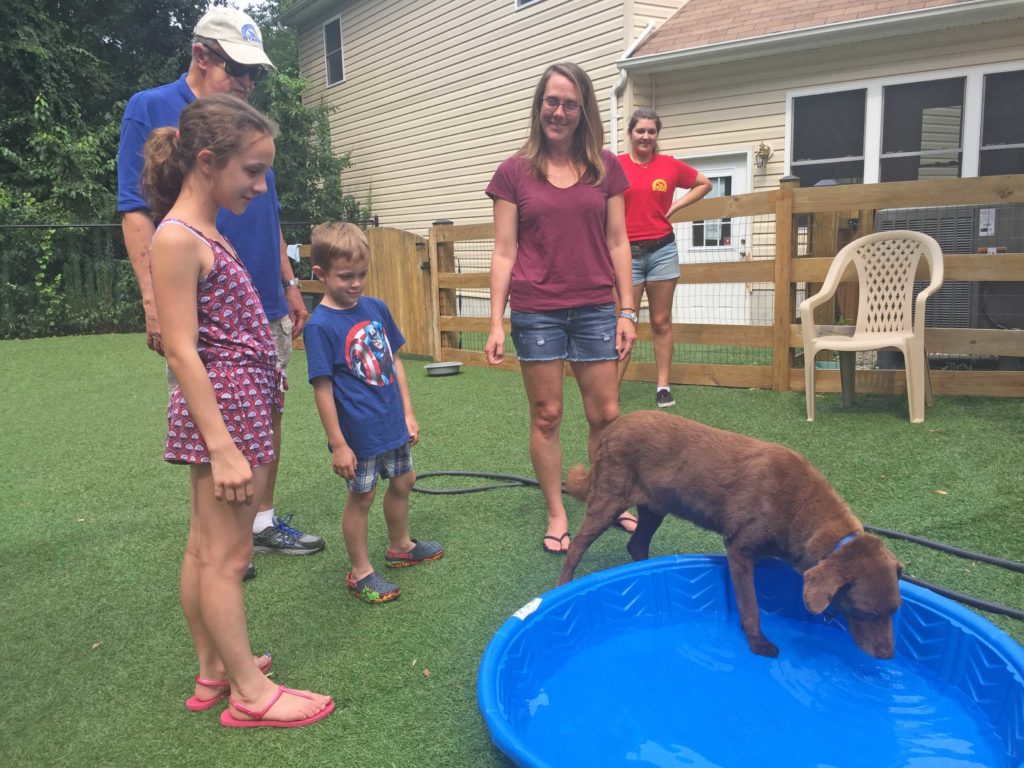Note: this is the first in a series of posts about what I learned during my visit to the Senior Dog Sanctuary (SDS) in Severn, MD, and how it might apply to Shep’s Place.
In Physics, I teach my students that the world can be described in terms of numbers: forces, velocities, energies. Though dog care can’t be reduced to a simple equation like Physics, numbers still tell the story. The variables may be different — dogs, people, space, money — but what you can accomplish is still constrained by the numbers you have to work with, and how much control you have over them.
Here are some of the numbers that SDS has to deal with. The county limits the number of dogs they can house, based on the acreage of the site, to 21 or 22 (I didn’t recall exactly). To help as many dogs as possible, they run as near to capacity as they can. Their mission is to take in older dogs, nurse them back to health if necessary, and find them homes. The goal is for the dogs to be short term residents, to find them a loving family, wish them well, and open their kennel space to another deserving dog. Given that older dogs are harder to place, the results have been phenomenal. In a year and a half, they have placed over 100 dogs, for a live-release adoption rate of 96%.
Public shelters are legally required to take in all animals that are brought to them. For example, Great Plains SPCA, where I volunteer, takes in 4000-5000 animals a year. To handle the inflow, they have to be large, high-volume facilities. Given that mandate, they do a fantastic job, as I’ve seen firsthand. SDS, on the other hand, is a private shelter (as Shep’s Place will be). They are not obligated to take in any particular dog. They focus on a specific niche, senior dogs, that requires extra care and time. They of course want to help as many as possible, but it boils down to numbers. How many dogs are in need? How many can they take? How long does it take to find them a home?
I was stunned to discover that SDS receives around 200 requests a week for dog placement, about 30 a day. Everyone involved with SDS is a serious dog lover, and in their hearts, they would love to save every one of those dogs. But, alas, you can’t escape the numbers, and the math is harsh. There are 21 slots, and they are all filled. You can’t add a dog unless you have an empty slot. To open a slot, a dog must be adopted or pass away. They adopt out about 3 dogs a week. So, do the math: on average, of the 200 requests a week, they can only take in 3, which is 1.5%.
On the drive in to SDS, I listened in as Val took a call from a person trying to place her dog. She said she had to travel a lot for her job, and didn’t think she could care for her dog any longer. Val asked about the dog’s health, his age, and if she had looked elsewhere. From the caller’s answers, you could tell she was more concerned about her own freedom than the welfare of the dog. He told her to fill out an application on line, but also to contact other rescue operations that specialized in her dog’s breed.
Many of SDS’s transfer requests come from other shelters, animal control, or rescue efforts. Others come from people who are facing legitimate difficulties: poor health, loss of income or home, even death of the owner. You can tell these people are primarily concerned with the welfare of the dog, and your heart goes out to them. But the sad fact is that a large number of requests come from people who simply want to get rid of their old dog. Some don’t want to face the difficult end-of-life decisions that have to be made; others just want to clear the deck of a responsibility they’ve grown tired of. (I asked Val why they don’t have a sign at the entrance of SDS, and he said if they did, people would dump off their dogs and drive away.) It’s hard not to become angry with those people, but in the end, it’s a waste of emotional energy to dwell on them.
The management of SDS spends a significant amount of time each week whittling the mountain of intake requests down to the most deserving cases. Even then, they are left with maybe 20 dogs, all deserving, with only 3 or 4 spaces to fill, so tough decisions have to be made. Which ones should they “pull” (take in)? What criteria should they use? If a certain dog requires an $8000 surgery, can you justify pulling him when you could use the same money to take in 3 other dogs? It’s hard! It can feel cold. But it’s unavoidable.
The simple truth is, you can’t save them all. If you want to do any good at all, you have to make peace with the fact that you can only help a fraction of the dogs in need. You have to convince yourself to feel good about those you do help, and not obsess about those you can’t. It’s difficult, and not everyone can do it. But it’s the price you pay.
To open space for more dogs, you have to find families to adopt the ones you have. However, at SDS, the welfare of the dogs is paramount. The shelter invests a lot of time, love, and resources making dogs ready for adoption, and they come to know and care deeply about them. Regardless of the numbers, they are not going to release a dog until they know it is going to a good home where it will be well taken care of. Unlike the SPCA, you can’t just walk into SDS and leave with a dog the same day. Families have to fill out applications, and SDS volunteers evaluate the applications, calling references and making home visits before they decide which family is a good fit for the dog. The quality of the adoptions is still more important than the quantity.
After learning about the harsh math of shelter life, I was fortunate to end my day at SDS by observing a family that came in looking to adopt a dog. The family had three children, one with special needs, and they wanted a mellow companion dog for the kids. We went into the play yard, and they brought out four dogs in succession. They gave each dog time to interact with the kids, to play or wander according to their personalities, while sharing their background stories. It took 45 minutes, but it was time well spent. Seeing the first bonds of affection develop between a dog and a family reminded me of what it’s all about. You can’t save them all, but for this dog and this family, just look at the good you can do.

